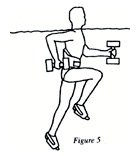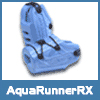Water Running Handbook – Part 8
Loading and Resistance
Loading:
The magic of water allows you to progressively add more weight or load to the body. By varying the depth of the water, you’re varying the load or the impact that you place on your body. As you progress downward to shallower and shallower water, you increase the load on the body. Using variable depths is very useful when recovering from an injury or when you’ve had a hard training session and you need to partially unload the body. Training at variable depths can often help prevent injuries and is an excellent cross-training procedure.
Resistive Equipment:
Note:
Make sure you have the mechanics of running refined before you use these resistive devices. Do not use them when injured without guidance from your rehabilitation professional.

On land, people use weights to add resistance. In the water, buoyancy and the surface area of an object are used to provide resistance that places stress on the body. A device is buoyancy resistive when its buoyancy makes it difficult to move the object down from the surface of the water. It is surface resistive when the surface area of the object makes it difficult to move through the water.
The intensity of the resistance for both buoyancy and surface resistive devices is increased in direct relationship to the speed at which they are moved through the water.

AquaRunners RX:
AquaRunners RX are both buoyancy and surface resistive and can be placed on the feet to increase the workload by making it more difficult to push the legs down and adding surface area resistance on the return. The faster the pace, the more resistance. Always consider the stress on your joints when adding resistance (loading) to an extremity. Start at a slow, easy level and give your joints and muscles time to recover and adapt to the added resistance. AquaRunners RX are not to be used for standing or running on the bottom of the pool in shallow water or on the deck. AquaRunners RX are designed to be used with a buoyancy belt.

DeltaBells™:
DeltaBells™ are hand-held buoyancy and surface resistive devices designed to condition the body’s upper extremity. Their buoyancy provides resistance when pushed away from the surface of the water, their surface area provides resistance when pushed or pulled by the limbs through the water. Their triangular shape allows you to push or pull either the flat or pointed shape through the water.
The flat surface provides more resistance than the point so you can vary the intensity with the turn of your wrist. The resistance effect is increased as the speed of the devices movement through the water is increased. Ordinary round water dumbbells are not as efficient for water running as the triangular shaped DeltaBells which can be turned flat side toward the body allowing arms to swing close to the body in correct running form.
Caution:
When using a buoyancy resistive device it is important to keep it below the surface of the water so there will be no radical change in movement when the device leaves the water or is pulled back under the surface.

WebPro Gloves:
WebPro Gloves Other resistive devices that runners find useful in the water are webbed gloves like the AquaJogger WebPro Gloves. You can vary the surface area and the resistance by spreading the fingers to catch more water as the hands are moved through the water. Webbed gloves allow movement of the hand through the correct range of running motion without compromising running form.
